weight Alfa Romeo MiTo 2012 Owner handbook (in English)
[x] Cancel search | Manufacturer: ALFA ROMEO, Model Year: 2012, Model line: MiTo, Model: Alfa Romeo MiTo 2012Pages: 262, PDF Size: 6.46 MB
Page 139 of 262
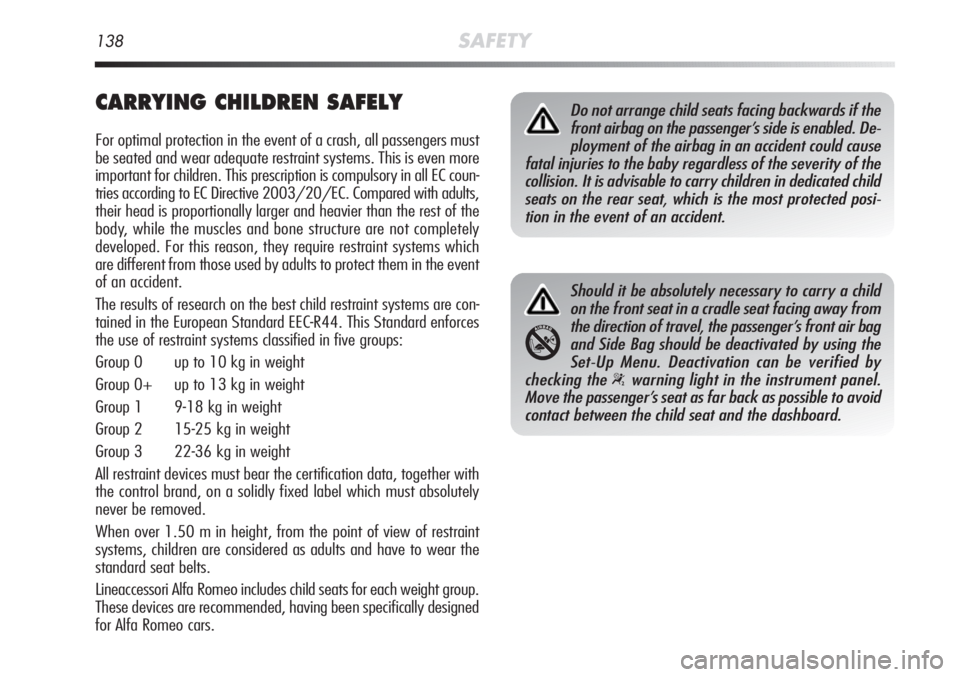
138SAFETY
CARRYING CHILDREN SAFELY
For optimal protection in the event of a crash, all passengers must
be seated and wear adequate restraint systems. This is even more
important for children. This prescription is compulsory in all EC coun-
tries according to EC Directive 2003/20/EC. Compared with adults,
their head is proportionally larger and heavier than the rest of the
body, while the muscles and bone structure are not completely
developed. For this reason, they require restraint systems which
are different from those used by adults to protect them in the event
of an accident.
The results of research on the best child restraint systems are con-
tained in the European Standard EEC-R44. This Standard enforces
the use of restraint systems classified in five groups:
Group 0 up to 10 kg in weight
Group 0+ up to 13 kg in weight
Group 1 9-18 kg in weight
Group 2 15-25 kg in weight
Group 3 22-36 kg in weight
All restraint devices must bear the certification data, together with
the control brand, on a solidly fixed label which must absolutely
never be removed.
When over 1.50 m in height, from the point of view of restraint
systems, children are considered as adults and have to wear the
standard seat belts.
Lineaccessori Alfa Romeo includes child seats for each weight group.
These devices are recommended, having been specifically designed
for Alfa Romeo cars.
Do not arrange child seats facing backwards if the
front airbag on the passenger’s side is enabled. De-
ployment of the airbag in an accident could cause
fatal injuries to the baby regardless of the severity of the
collision. It is advisable to carry children in dedicated child
seats on the rear seat, which is the most protected posi-
tion in the event of an accident.
Should it be absolutely necessary to carry a child
on the front seat in a cradle seat facing away from
the direction of travel, the passenger’s front air bag
and Side Bag should be deactivated by using the
Set-Up Menu. Deactivation can be verified by
checking the
“warning light in the instrument panel.
Move the passenger’s seat as far back as possible to avoid
contact between the child seat and the dashboard.
Page 140 of 262
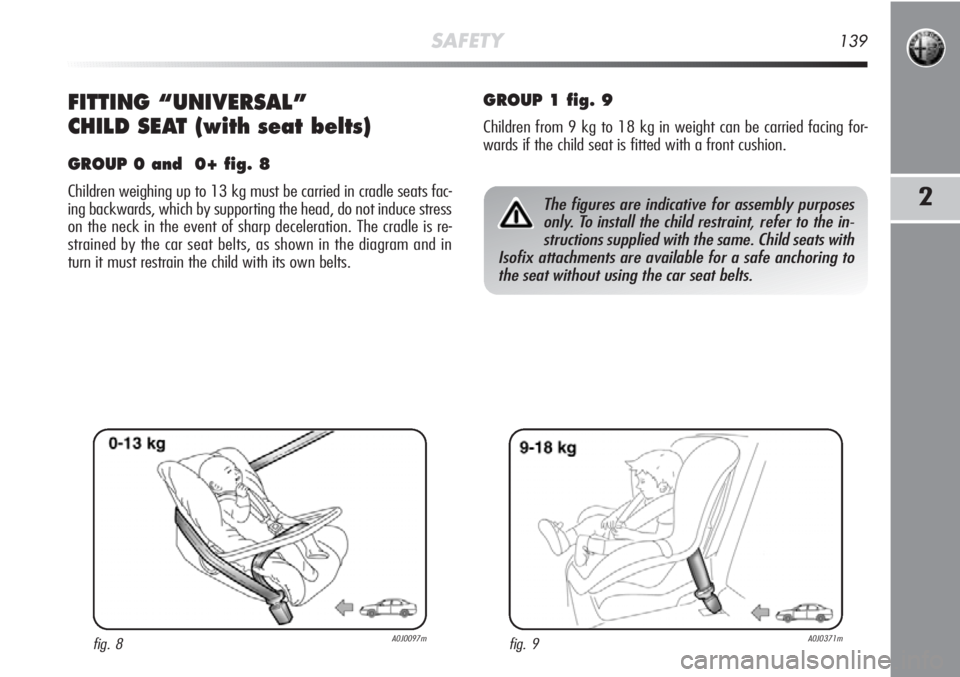
SAFETY139
2
FITTING “UNIVERSAL”
CHILD SEAT (with seat belts)
GROUP 0 and 0+ fig. 8
Children weighing up to 13 kg must be carried in cradle seats fac-
ing backwards, which by supporting the head, do not induce stress
on the neck in the event of sharp deceleration. The cradle is re-
strained by the car seat belts, as shown in the diagram and in
turn it must restrain the child with its own belts.
fig. 8A0J0097mfig. 9A0J0371m
The figures are indicative for assembly purposes
only. To install the child restraint, refer to the in-
structions supplied with the same. Child seats with
Isofix attachments are available for a safe anchoring to
the seat without using the car seat belts.
GROUP 1 fig. 9
Children from 9 kg to 18 kg in weight can be carried facing for-
wards if the child seat is fitted with a front cushion.
Page 142 of 262
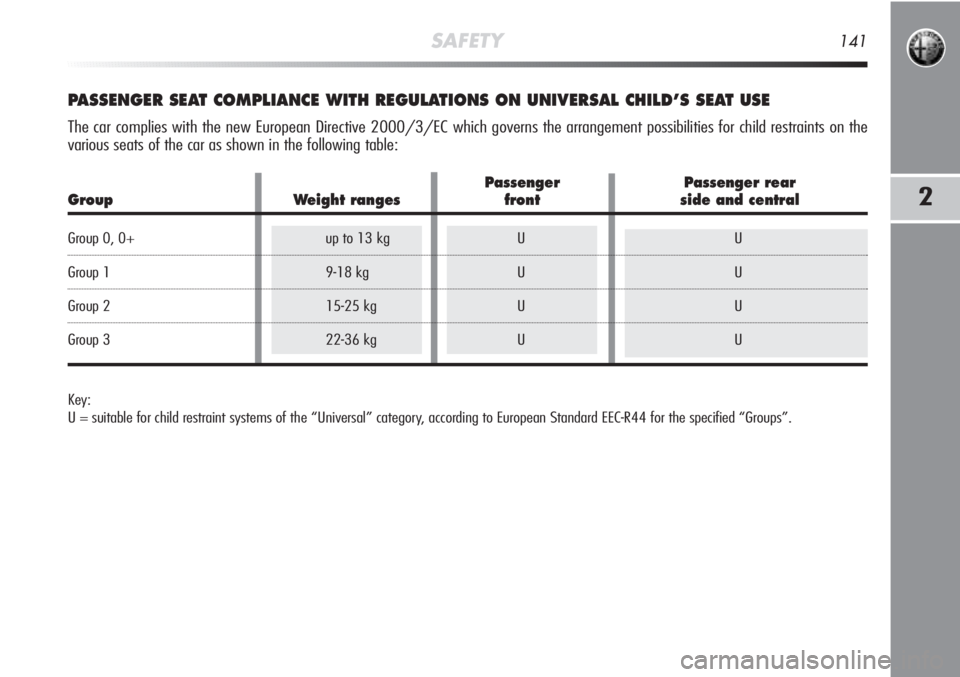
SAFETY141
2
PASSENGER SEAT COMPLIANCE WITH REGULATIONS ON UNIVERSAL CHILD’S SEAT USE
The car complies with the new European Directive 2000/3/EC which governs the arrangement possibilities for child restraints on the
various seats of the car as shown in the following table:
Key:
U = suitable for child restraint systems of the “Universal” category, according to European Standard EEC-R44 for the specified “Groups”.
Passenger Passenger rear
Group Weight ranges front side and central
Group 0, 0+ up to 13 kg U U
Group 1 9-18 kg U U
Group 2 15-25 kg U U
Group 3 22-36 kg U U
Page 144 of 262
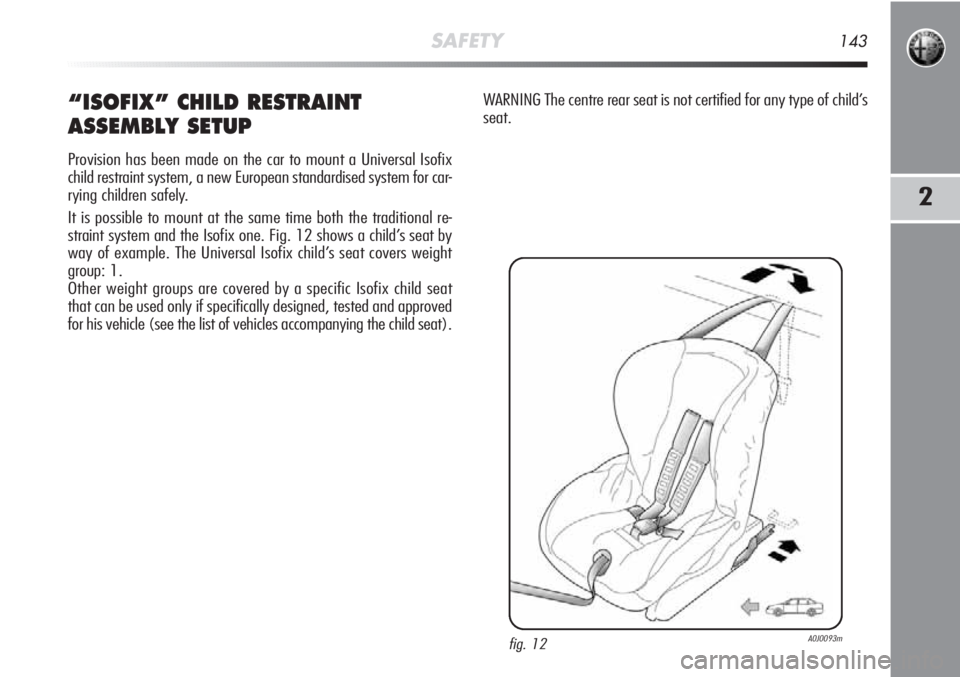
SAFETY143
2
“ISOFIX” CHILD RESTRAINT
ASSEMBLY SETUP
Provision has been made on the car to mount a Universal Isofix
child restraint system, a new European standardised system for car-
rying children safely.
It is possible to mount at the same time both the traditional re-
straint system and the Isofix one. Fig. 12 shows a child’s seat by
way of example. The Universal Isofix child’s seat covers weight
group: 1.
Other weight groups are covered by a specific Isofix child seat
that can be used only if specifically designed, tested and approved
for his vehicle (see the list of vehicles accompanying the child seat).
fig. 12A0J0093m
WARNING The centre rear seat is not certified for any type of child’s
seat.
Page 146 of 262
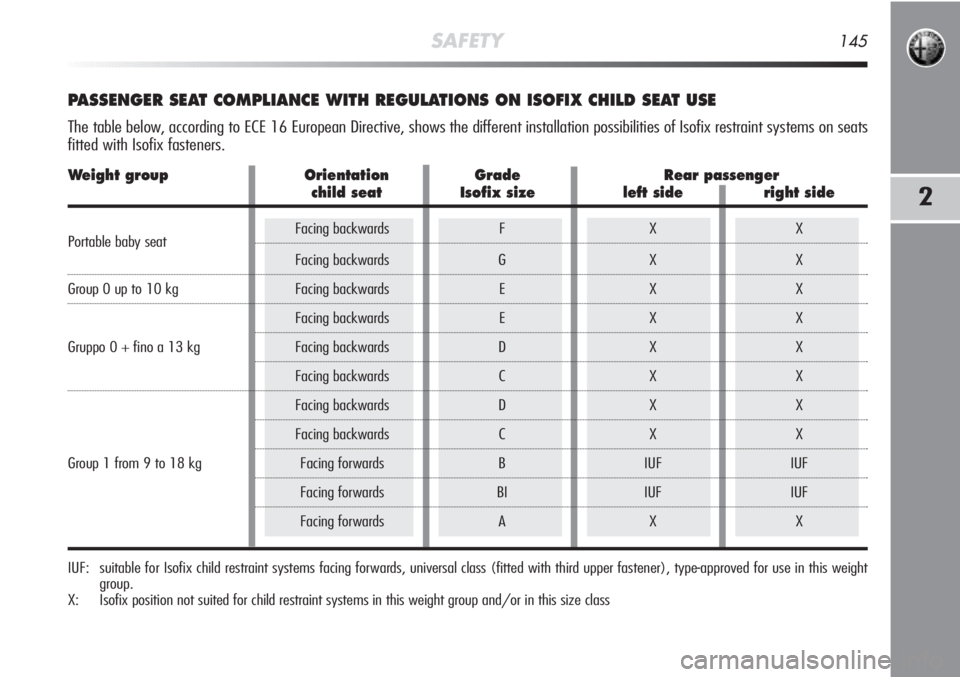
SAFETY145
2
PASSENGER SEAT COMPLIANCE WITH REGULATIONS ON ISOFIX CHILD SEAT USE
The table below, according to ECE 16 European Directive, shows the different installation possibilities of Isofix restraint systems on seats
fitted with Isofix fasteners.
IUF: suitable for Isofix child restraint systems facing forwards, universal class (fitted with third upper fastener), type-approved for use in this weight
group.
X: Isofix position not suited for child restraint systems in this weight group and/or in this size class
Weight group Orientation Grade Rear passenger
child seat Isofix size left side right side
Portable baby seatFacing backwards F X X
Facing backwards G X X
Group 0 up to 10 kg Facing backwards E X X
Facing backwards E X X
Gruppo 0 + fino a 13 kg Facing backwards D X X
Facing backwards C X X
Facing backwards D X X
Facing backwards C X X
Group 1 from 9 to 18 kg Facing forwards B IUF IUF
Facing forwards BI IUF IUF
Facing forwards A X X
Page 159 of 262
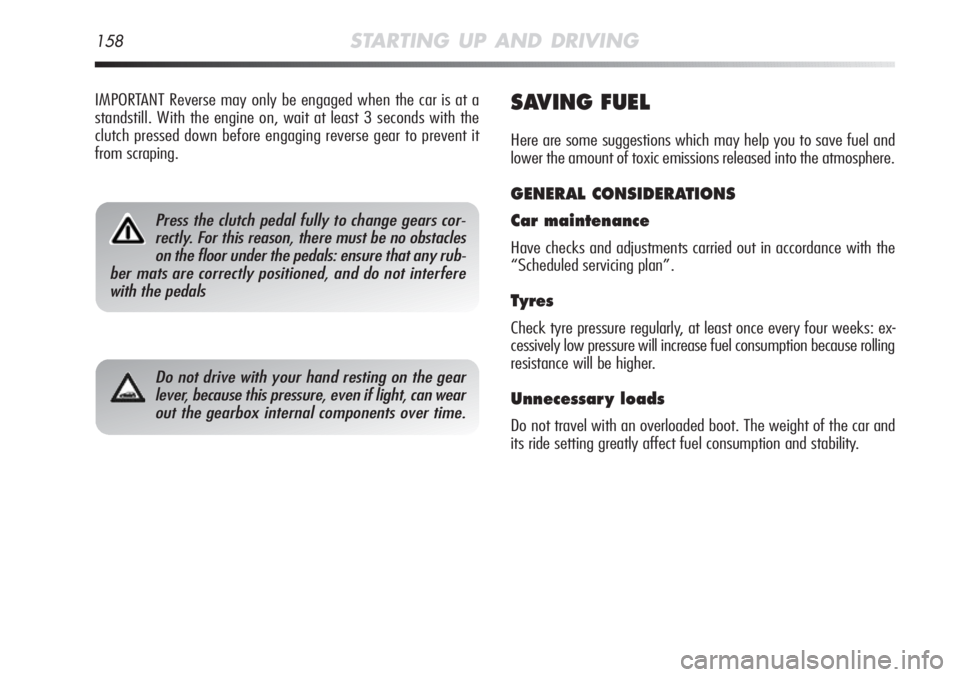
158STARTING UP AND DRIVING
SAVING FUEL
Here are some suggestions which may help you to save fuel and
lower the amount of toxic emissions released into the atmosphere.
GENERAL CONSIDERATIONS
Car maintenance
Have checks and adjustments carried out in accordance with the
“Scheduled servicing plan”.
Tyres
Check tyre pressure regularly, at least once every four weeks: ex-
cessively low pressure will increase fuel consumption because rolling
resistance will be higher.
Unnecessar y loads
Do not travel with an overloaded boot. The weight of the car and
its ride setting greatly affect fuel consumption and stability.
Press the clutch pedal fully to change gears cor-
rectly. For this reason, there must be no obstacles
on the floor under the pedals: ensure that any rub-
ber mats are correctly positioned, and do not interfere
with the pedals
Do not drive with your hand resting on the gear
lever, because this pressure, even if light, can wear
out the gearbox internal components over time.
IMPORTANT Reverse may only be engaged when the car is at a
standstill. With the engine on, wait at least 3 seconds with the
clutch pressed down before engaging reverse gear to prevent it
from scraping.
Page 161 of 262

160STARTING UP AND DRIVING
Acceleration
Sudden acceleration has a very negative effect on fuel consump-
tion and emissions: accelerate gradually and do not go over the
maximum torque ratio.
CONDITIONS OF USE
Cold starting
Short distances and frequent cold start-ups will prevent the en-
gine from reaching optimal running temperature. Consequently,
both fuel consumption (from +15 to +30% on an urban cycle )
and emissions will increase.
Traffic and road conditions
Rather high fuel consumption is caused by heavy traffic, for instance
when travelling in a queue with frequent use of low gears or in
cities with many traffic lights. Mountain and rough roads also have
a negative effect on fuel consumption.
Traffic hold-ups
During prolonged hold-ups (level crossings) the engine should be
switched off.
TOWING TRAILERS
IMPORTANT NOTES
The vehicle must be provided with a type-approved tow hook and
adequate electrical system to tow caravans or trailers. Installation
must be carried out by a specialist.
Install any specific and/or additional rear-view mirrors as specified
by law.
Remember that when towing a trailer, steep hills are harder to
climb, braking distances increase and overtaking takes longer de-
pending on the overall weight.
Engage a low gear when driving downhill, rather than constantly
using the brake.
The weight of the trailer reduces the load capacity of the vehicle
by the same amount. Consider the weight of the fully-laden vehi-
cle weight, including accessories and luggage, to make sure you
do not exceed the maximum towable weight (shown on the reg-
istration certificate).
Respect the speed limits specific to each country for vehicles tow-
ing trailers. In any event do not exceed 100 km/h.
Page 168 of 262
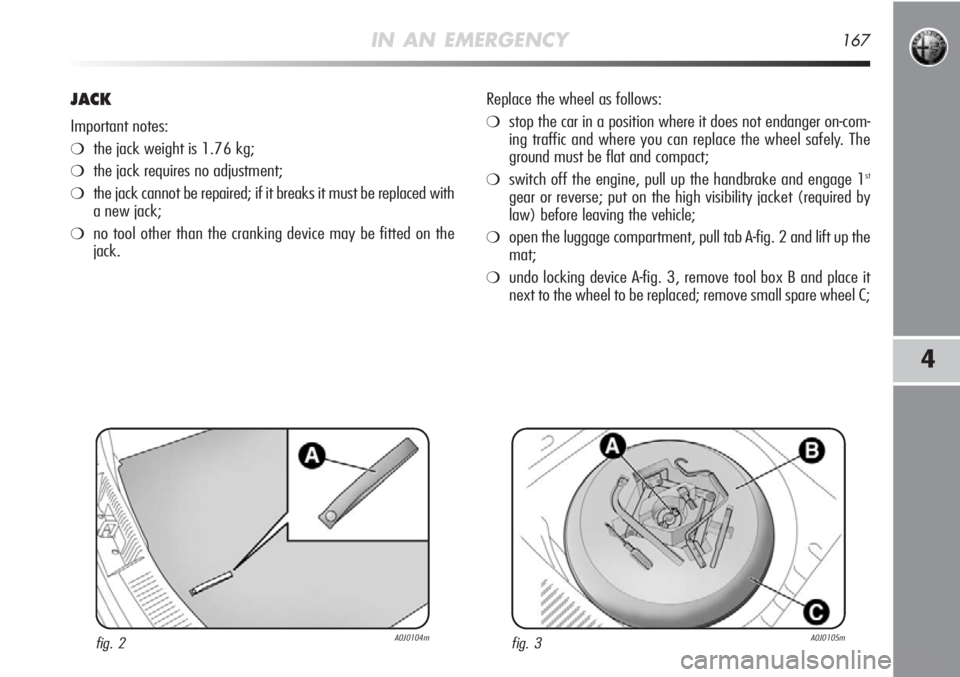
IN AN EMERGENCY167
4
JACK
Important notes:
❍the jack weight is 1.76 kg;
❍the jack requires no adjustment;
❍the jack cannot be repaired; if it breaks it must be replaced with
a new jack;
❍no tool other than the cranking device may be fitted on the
jack.Replace the wheel as follows:
❍stop the car in a position where it does not endanger on-com-
ing traffic and where you can replace the wheel safely. The
ground must be flat and compact;
❍switch off the engine, pull up the handbrake and engage 1st
gear or reverse; put on the high visibility jacket (required by
law) before leaving the vehicle;
❍open the luggage compartment, pull tab A-fig. 2 and lift up the
mat;
❍undo locking device A-fig. 3, remove tool box B and place it
next to the wheel to be replaced; remove small spare wheel C;
fig. 2A0J0104mfig. 3A0J0105m
Page 228 of 262
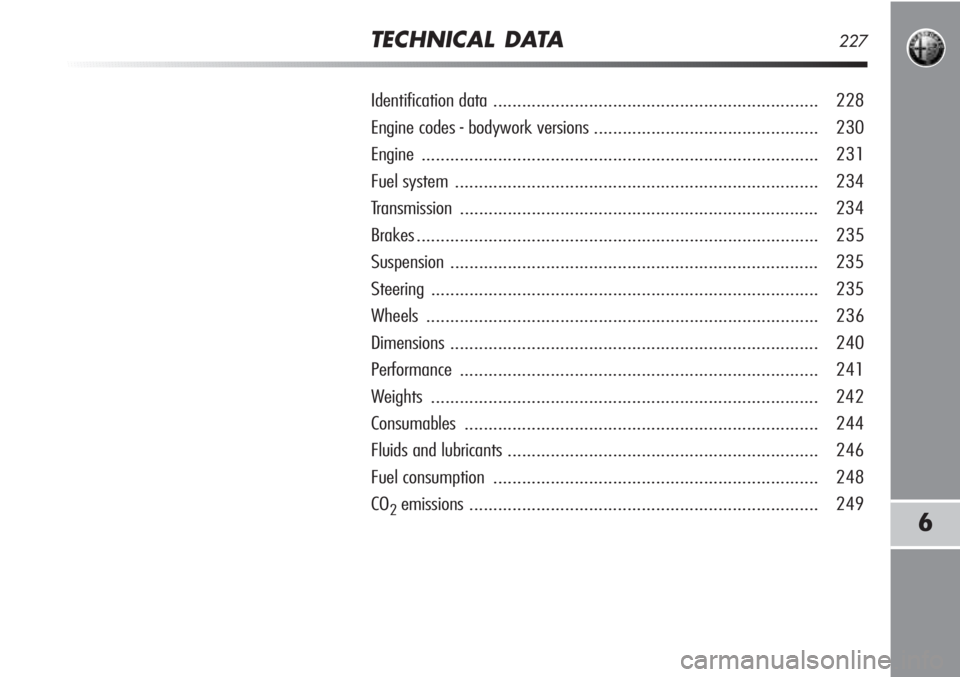
Identification data .................................................................... 228
Engine codes - bodywork versions............................................... 230
Engine................................................................................... 231
Fuel system ............................................................................ 234
Transmission ........................................................................... 234
Brakes.................................................................................... 235
Suspension ............................................................................. 235
Steering ................................................................................. 235
Wheels .................................................................................. 236
Dimensions ............................................................................. 240
Performance ........................................................................... 241
Weights ................................................................................. 242
Consumables .......................................................................... 244
Fluids and lubricants ................................................................. 246
Fuel consumption.................................................................... 248
CO
2emissions ......................................................................... 249
6
TECHNICAL DATA227
Page 229 of 262

IDENTIFICATION DATA
The vehicle identification details are:
❍Identification plate;
❍Chassis marking;
❍Bodytwork paint plate;
❍Engine marking.
IDENTIFICATION PLATE fig. 1
The plate is to be found on the left side of the boot floor and it
bears the following identification data:
B Homologation number.
C Vehicle type code.
D Chassis number.
E Maximum vehicle weight fully loaded.
F Maximum vehicle weight fully loaded with trailer.
G Maximum vehicle weight on front axle.
H Maximum vehicle weight on rear axle.
I Engine type.
L Body version code.
M Spare part code.
N Smoke opacity index (for diesel engines).
fig. 1A0J0161m
228TECHNICAL DATA